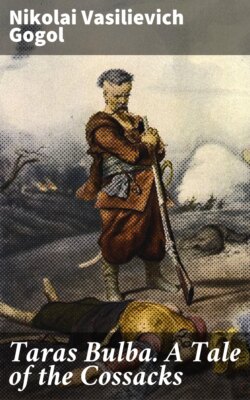Taras Bulba. A Tale of the Cossacks

Реклама. ООО «ЛитРес», ИНН: 7719571260.
Оглавление
Nikolai Vasilievich Gogol. Taras Bulba. A Tale of the Cossacks
Taras Bulba. A Tale of the Cossacks
Table of Contents
ALFRED A. KNOPF. NEW YORK MCMXVI
TABLE
Introduction
Chapter one
Chapter two
Chapter three
Chapter four
Chapter five
Chapter six
Chapter seven
Chapter eight
Chapter nine
Chapter ten
Chapter eleven
Chapter twelve
Отрывок из книги
Nikolai Vasilievich Gogol
Published by Good Press, 2021
.....
About one hundred and sixty-five miles below Yekaterinoslav, opposite Alexandrovsk, in the Dnyeper, lies the Island of Khortitza, where stood the first Syech. Originally—so the ancient Greek chronicles state—this beautiful island held a monastery inhabited by many monks. The Russians, it is said, had regarded it as a sacred place, and (before the introduction of Christianity) sacrificed there to their deities birds, and even the highly-prized dogs of the sort now known as Borzói, or Russian Wolf-hounds. Here, in the beginning of 1550, Dmitry Vishnevetzky built a fortress, and assembled kazakdom around him. Vishnevetzky was a fairly wealthy magnate, owner of several villages in southern Volhynia. Instead of following the example of the men of his day and modestly increasing and rounding out his "fortune," he devoted himself to the fashionable sport of the period on the Border Marches—fighting the Tatárs. He entered the public arena in 1540, but, not content with defensive fighting, such as was carried on by the Border Chieftains, and magnates, he made up his mind to realise, in concrete form, the idea evidently cherished by many people of that epoch, but, so far, not put into execution, and built a castle on the islands of the Dnyeper, as a bulwark against the Tatárs. This idea of Vishnevetzky to found a permanent, strongly-fortified position on an island of the Dnyeper, did not fail to exercise an influence on the existing tendency to connect the winter camps of the hunters and fishermen into a chain of small fortresses defended by stockades, which, in turn, connected with a central kosh, or camp, whose ruler was the Koshevói—the chief of the camp—on the Lowlands. But Vishnevetzky's experiment with Khortitza Castle proved that no reliance could be placed on strong walls and cannon as defences against the Turks and the Tatárs, who would find means for overcoming them. In January, 1557, the Khan of the Crimea attacked Khortitza Castle, in vain: but it was evident that some inaccessible location must be chosen; so the Sicha began to lead a nomadic life, like its inhabitants. The original kurén, which came, in the end, to signify a large barrack (and the troop which occupied it), was a small wooden shack, mounted on wheels, which enabled it to gallop after its owner, when the Sicha began its wanderings among the labyrinth of islands, shallows and bays, where the estuary of the Dnyeper ebbed and flowed. Such a Sicha could not, obviously, be made a centre all at once, and its origin, in the usual sense, must be ascribed to the ten years or so following Vishnevetzky's experiment and failure. It moved on down the Dyneper in agile bounds—and then returned, apparently, twice, to locations close to some previously occupied and abandoned.
The pathetic picture of the old Kazák gazing out across the Black Sea and mourning for his Ostap would suggest that the Syech to which Bulba returned after the defeat might have been Number Seven—the one situated at Aleshki, twelve miles from Kherson, on the salty lagoon of the Dnyeper—one of the famous "limans" in the neighbourhood of the Black Sea, whose bottom-slime constitutes a famous remedy for scrofula, gout, rheumatism, nervous and cutaneous diseases. This Syech, which lasted for twenty-five years (their existence was, as a rule, rather brief), was the only one within easy riding distance of the Black Sea. But the statement that the Syech was then situated at Khortitza contradicts such a theory. That statement also proves that the "Union" alluded to was the political arrangement described in my Footnote. Another "Union" equally famous and productive of battle deserves mention under existing circumstances, although later in date by at least thirty years (presumably) than the death of Taras.
.....